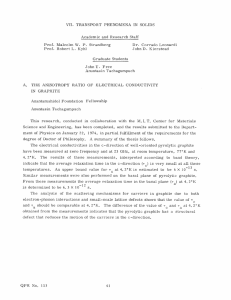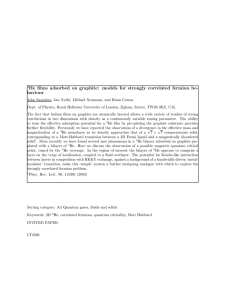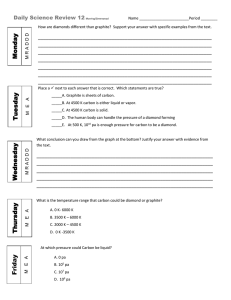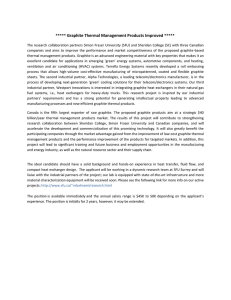Thermal stability
advertisement
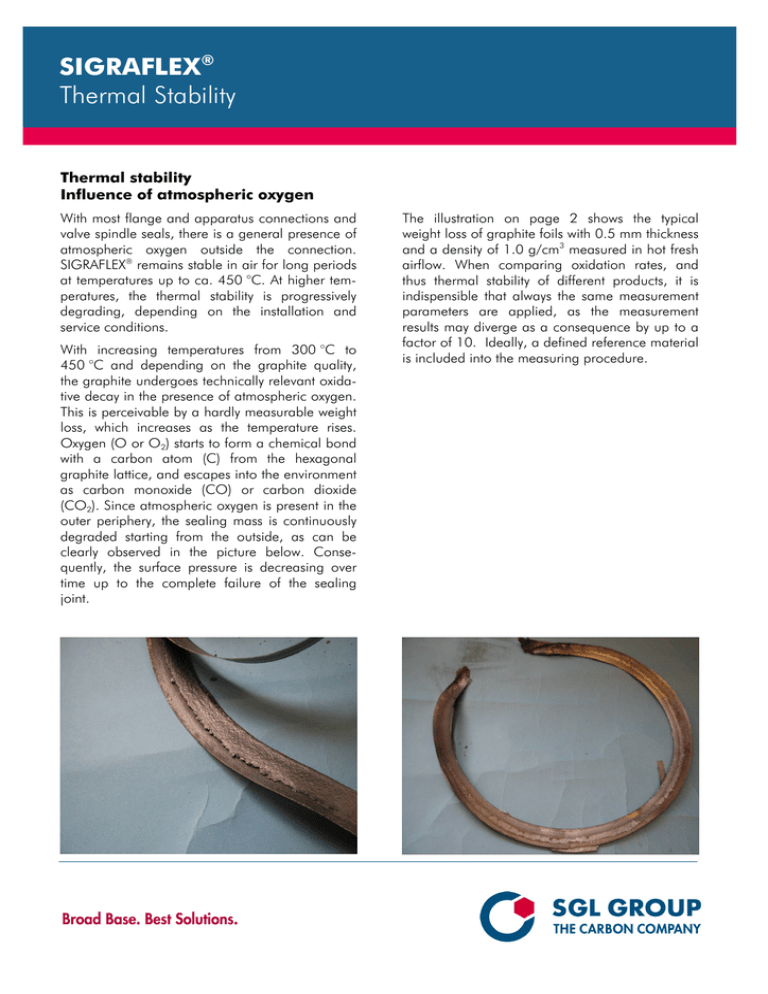
SIGRAFLEX® Thermal Stability Thermal stability Influence of atmospheric oxygen With most flange and apparatus connections and valve spindle seals, there is a general presence of atmospheric oxygen outside the connection. SIGRAFLEX® remains stable in air for long periods at temperatures up to ca. 450 °C. At higher temperatures, the thermal stability is progressively degrading, depending on the installation and service conditions. With increasing temperatures from 300 °C to 450 °C and depending on the graphite quality, the graphite undergoes technically relevant oxidative decay in the presence of atmospheric oxygen. This is perceivable by a hardly measurable weight loss, which increases as the temperature rises. Oxygen (O or O2) starts to form a chemical bond with a carbon atom (C) from the hexagonal graphite lattice, and escapes into the environment as carbon monoxide (CO) or carbon dioxide (CO2). Since atmospheric oxygen is present in the outer periphery, the sealing mass is continuously degraded starting from the outside, as can be clearly observed in the picture below. Consequently, the surface pressure is decreasing over time up to the complete failure of the sealing joint. The illustration on page 2 shows the typical weight loss of graphite foils with 0.5 mm thickness and a density of 1.0 g/cm3 measured in hot fresh airflow. When comparing oxidation rates, and thus thermal stability of different products, it is indispensible that always the same measurement parameters are applied, as the measurement results may diverge as a consequence by up to a factor of 10. Ideally, a defined reference material is included into the measuring procedure. SIGRAFLEX® Thermal Stability gasket produce a "barrier" between gasket and atmospheric oxygen. As a result, the service life of SIGRAFLEX gaskets at high temperatures is much longer. In a petrochemical residue vacuum distillation unit operated at approx. 400 °C, however, atmospheric oxygen diffuses into the gasket from the outside as a result of the internal partial vacuum. This actually accelerates oxidation. Experience suggests there is no risk involved in short-term exposure to temperatures up to 600 °C, unless the service temperature remains elevated for a prolonged duration. Contrary to many other materials used in sealing technology, graphite does not suffer from pre-damage due to high temperatures, but is solely subject to a loss of mass over time. When used in conventional stuffing box packings, however, the oxidation rate of SIGRAFLEX is usually much lower. The reasons are as follows: • Higher density of the graphite (usually 1.4 - 1.8 g/cm³) • Greater mass in combination with a reduced surface area exposed to attack (favorable surface-to-volume ratio) • Barrier effect of operating medium such as steam, which permeates the seal from within and thereby impedes diffusion of oxygen into the seal from the outside • Enclosed installation • The stuffing box is usually much cooler than the operating medium. Gaskets are governed by similar laws. Here, too, the flange temperature is lower than the mean service temperature. In the case of non-insulated piping, the difference often amounts to ca. 5080 °C. A distinction should be made, however, between gaskets operated in non-oxidizing media under elevated internal pressure, or, in a worst-case scenario, gaskets exposed to atmospheric oxygen in a unit operated under vacuum. In the case of a steam line operated at 500 °C, small amounts of steam diffusing through the 2 Quantitative predictions about precise service life cycles are difficult to make, as they are governed by the individual installation and service conditions, which can vary widely. Thus, the following values for the typical service life may only serve as a very rough estimate for a correctly designed and mounted stuffing box packing made from SIGRAFLEX graphite foil, or a punched SIGRAFLEX flange gasket. Presupposing that the operating medium is under positive pressure and does not contain oxidizing substances, the following, non-binding guideline values are applicable: Approximately fifty years at 400 °C, ca. ten years at 450 °C, ca. two years at 500 °C, ca. half a year at 550 °C and approximately one month at 600 °C. It is indispensable that an individual estimation is performed for each case! Caution: Competitor material available on the market generally exhibits a significantly lower service life. As a general rule, caution has to be exercised with manufacturer’s specification for maximum operating temperatures. While the specifications of SGL Group often refer to safe operation of five to ten years, other manufacturers confine themselves to the specification of shortterm temperatures. Between those two specifications items, however, there is a difference of several 100 °C. SIGRAFLEX® Thermal Stability 20 19 18 17 16 15 14 13 11 10 Thus, statements made in the past saying oxidization rates increase over-proportionally with increasing ash content are only partially correct. On average, the tendency of graphite foils with high impurity levels oxidizing more rapidly still holds true for the majority of material available on the market, as a low level of impurities often translates into a low amount of elements having a catalyzing effect to oxidization. However, the type of impurity and the applied production process have a much stronger influence on the product longevity than the ash content itself. That is why high-purity graphite foil with an ash content of ca. 0.15% can be found on the market which was measured at a 20 times higher oxidization rate than high-grade graphite foil with 2% ash content. The following illustration compares the typical loss of mass of different graphite foils. 6 5 4 3 2 1 SIGRAFLEX APX2 Foil 7 SIGRAFLEX APX Foil 8 SIGRAFLEX Z Foil Besides temperature, the surface area of attack by atmospheric oxygen and the tightness, the oxidisation rate is primarily influenced by the graphite quality. The quality is predominately determined by the elemental composition of the raw material natural graphite and the production process of the graphite foil. SIGRAFLEX E Foil 9 Typ. graphite foil of Far-Eastern origin 12 SIGRAFLEX C Foil To a certain degree, flange gaskets are protected from ingress of atmospheric oxygen by flange sealing strips. Slightly longer service life can be achieved if the cut edges of the gasket, which are exposed to oxidising medium or atmospheric oxygen, are additionally enclosed by formed flange made of stainless-steel. In order to fully unfold its protective effect, the formed flange must be completely sealed off by the flange sealing strips. 0 In cases of operating temperatures exceeding 450 °C, it is generally recommended to consult the gasket material manufacturer. Stability in other media at temperatures above 450 °C As a matter of course, the following specifications are only applicable if SIGRAFLEX graphite is not exposed anywhere to atmospheric oxygen. For logical reasons, only inorganic compounds or elements can be discussed here, as nearly all organic compounds – i.e. the operating media – are chemically instable at such high temperatures. The following specifications apply exclusively to SIGRAFLEX graphite; however, they are not applicable to stainless steel reinforcements used in some SIGRAFLEX products. Also, in combination with these metal inserts made from ASTM 316, the limitation to 800 °C must be observed. Inorganic gases • Noble gases (e. g. helium, argon, xenon): SIGRAFLEX graphite is fully stable up to around 3,000 °C, beyond 2,000 °C gradual embrittlement setting in. • Nitrogen (N2): Starting from ca. 1,600 °C cyanogen formation sets in under nitrogen atmosphere. In the presence of hydrogen (re- 3 SIGRAFLEX® Thermal Stability duction of water vapor), formation of hydrogen cyanide (HCN) takes place. • • Carbon dioxide (CO2): Starting from ca. 600 °C a slight attack sets in, which has almost no technical relevance up to 800 °C. At this point, carbon monoxide (CO) starts to form. Water vapor (H2O): Starting from ca. 600 °C a slight attack sets in, which has almost no technical relevance up to 700 °C. Depending on the temperature, carbon monoxide, carbon dioxide, hydrogen and methane (from hydrogen in a secondary reaction) are formed. • Hydrogen (H2): Starting from ca. 900 °C methane formation is possible under hydrogen atmosphere. • Oxygen (O2): Under pure oxygen atmosphere, SIGRAFLEX remains stable up to ca. 300 °C. • Ozone (O3): Under pure ozone atmosphere, SIGRAFLEX graphite remains stable up to ca. 150 °C. SIGRAFLEX graphite is not resistant, for example, to sulphur trioxide, bromine, fluorine. SIGRAFLEX graphite is resistant, for example, to ammonia, hydrogen sulphide, sulphur dioxide, hydrogen chloride, carbon monoxide. If required, the respective operational limits must be determined experimentally for each application. Please also observe our technical information about media resistance. Molten salts Graphite is not resistant to melts with a strong oxidization potential, e.g. potassium chlorate, potassium nitrate, sodium peroxide. Molten metals SIGRAFLEX is stable up to the carbide formation level, except for alkali melts. Suitability of SIGRAFLEX gasket materials for use with oxygen On the basis of the test results obtained by the Federal Institute for Materials Research and Testing (BAM), Berlin/ Germany, there are no objections on safety grounds to the use of SIGRAFLEX for sealing flange joints made from copper, copper alloys or steel at oxygen pressures up to 130 bar and temperatures up to 200 °C. (For some products, tests are also available for higher temperatures.) This applies equally to flanges with raised faces, projections and recesses or tongue-and-groove structures. “There are no objections, either, to the use of the listed SIGRAFLEX materials in plants or plant components for liquid oxygen. Since pressure exerted on liquid oxygen causes no appreciable changes in concentration, i.e. has no significant influence on the reactivity of the material, restriction to a specific pressure range is not required.“1) 1) Source: BAM - Test report on the suitability of a gasket material for use with oxygen ® registered trademark of SGL Group companies 10 2011/0 2NÄ Printed in Germany This information is based on our present state of knowledge and is intended to provide general notes on our products and their uses. It should therefore not be construed as guaranteeing specific properties of the products described or their suitability for a particular application. Any existing industrial property rights must be observed. The quality of our products is guaranteed under our “General Conditions of Sale”. Graphite Specialties | SGL CARBON GmbH Phone +49 8271 83-2276 | expandedgraphite@sglcarbon.de www.sigraflex.eu | www.sglgroup.com 4
